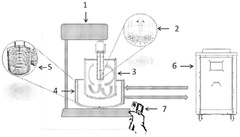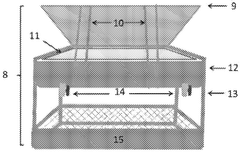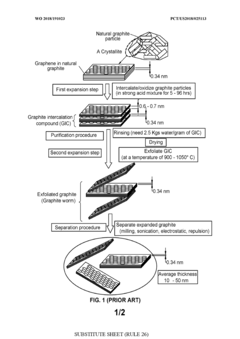Sustainable Graphene Synthesis: Eco-Friendly Production Techniques
MAY 13, 20258 MIN READ
Generate Your Research Report Instantly with AI Agent
Patsnap Eureka helps you evaluate technical feasibility & market potential.
Graphene Synthesis Evolution and Objectives
Graphene, a two-dimensional carbon allotrope, has captivated the scientific community since its isolation in 2004 due to its exceptional properties and potential applications across various industries. The evolution of graphene synthesis techniques has been marked by significant milestones, each addressing the challenges of scalability, quality, and environmental impact. Initially, the mechanical exfoliation method, while groundbreaking, was limited in its production capacity. This led to the development of chemical vapor deposition (CVD) techniques, which allowed for larger-scale production but often relied on energy-intensive processes and hazardous chemicals. As the demand for graphene grew, so did the need for more sustainable and eco-friendly production methods. The field has since witnessed a shift towards greener synthesis approaches, including the use of renewable precursors, low-temperature processes, and bio-inspired techniques. This evolution reflects the growing awareness of environmental concerns and the push towards sustainable manufacturing practices in the materials science sector. The current research landscape is focused on developing production techniques that not only yield high-quality graphene but also minimize environmental impact and resource consumption. Objectives in this field include optimizing energy efficiency, reducing waste generation, and exploring the use of renewable carbon sources. Researchers are investigating methods such as electrochemical exfoliation using aqueous electrolytes, plasma-enhanced CVD with lower energy requirements, and the use of biomass-derived precursors for graphene synthesis. Additionally, there is a growing interest in circular economy approaches, where graphene production is integrated into waste management systems, potentially using carbon-rich waste materials as feedstock. The ultimate goal is to establish scalable, cost-effective, and environmentally benign processes that can meet the increasing industrial demand for graphene while aligning with global sustainability goals. This research direction not only addresses the technical challenges of graphene synthesis but also contributes to the broader objectives of green chemistry and sustainable materials production, positioning graphene as a key material in the transition towards a more sustainable technological future.
Market Demand for Sustainable Graphene
The market demand for sustainable graphene has been steadily increasing in recent years, driven by growing environmental concerns and the need for eco-friendly production methods across various industries. As graphene continues to demonstrate its potential in numerous applications, from electronics to energy storage and biomedical devices, the emphasis on sustainable production techniques has become paramount. This shift is largely attributed to the increasing awareness of the environmental impact of traditional graphene synthesis methods, which often involve harsh chemicals and energy-intensive processes.
The global graphene market is projected to grow significantly, with some estimates suggesting a compound annual growth rate (CAGR) of over 30% in the coming years. A substantial portion of this growth is expected to be driven by demand for sustainably produced graphene. Industries such as automotive, aerospace, and consumer electronics are particularly interested in incorporating eco-friendly graphene into their products to meet stringent environmental regulations and consumer expectations.
The push for sustainable graphene is also fueled by government initiatives and funding programs aimed at promoting green technologies. For instance, the European Union's Graphene Flagship program has allocated significant resources to develop environmentally friendly graphene production methods. Similarly, countries like China, Japan, and South Korea have implemented policies to support the development of sustainable nanomaterials, including graphene.
Market analysis indicates that end-users are increasingly willing to pay a premium for sustainably produced graphene, recognizing the long-term benefits of reduced environmental impact and improved corporate social responsibility. This trend is particularly evident in sectors such as renewable energy, where graphene's potential in solar cells and energy storage devices aligns well with the overall sustainability goals.
However, challenges remain in scaling up sustainable graphene production to meet growing market demands. The current production capacity for eco-friendly graphene is limited, and prices remain relatively high compared to conventionally produced graphene. This presents both a challenge and an opportunity for companies investing in sustainable production techniques.
Despite these challenges, the market outlook for sustainable graphene remains highly positive. As production techniques improve and economies of scale are achieved, the cost gap between sustainably and conventionally produced graphene is expected to narrow. This, coupled with increasing regulatory pressure and consumer demand for environmentally friendly products, is likely to drive further growth in the sustainable graphene market.
In conclusion, the market demand for sustainable graphene is robust and growing, underpinned by environmental concerns, regulatory pressures, and the material's vast potential across multiple industries. As research and development in eco-friendly production techniques continue to advance, the market is poised for significant expansion, offering substantial opportunities for companies at the forefront of sustainable graphene synthesis.
The global graphene market is projected to grow significantly, with some estimates suggesting a compound annual growth rate (CAGR) of over 30% in the coming years. A substantial portion of this growth is expected to be driven by demand for sustainably produced graphene. Industries such as automotive, aerospace, and consumer electronics are particularly interested in incorporating eco-friendly graphene into their products to meet stringent environmental regulations and consumer expectations.
The push for sustainable graphene is also fueled by government initiatives and funding programs aimed at promoting green technologies. For instance, the European Union's Graphene Flagship program has allocated significant resources to develop environmentally friendly graphene production methods. Similarly, countries like China, Japan, and South Korea have implemented policies to support the development of sustainable nanomaterials, including graphene.
Market analysis indicates that end-users are increasingly willing to pay a premium for sustainably produced graphene, recognizing the long-term benefits of reduced environmental impact and improved corporate social responsibility. This trend is particularly evident in sectors such as renewable energy, where graphene's potential in solar cells and energy storage devices aligns well with the overall sustainability goals.
However, challenges remain in scaling up sustainable graphene production to meet growing market demands. The current production capacity for eco-friendly graphene is limited, and prices remain relatively high compared to conventionally produced graphene. This presents both a challenge and an opportunity for companies investing in sustainable production techniques.
Despite these challenges, the market outlook for sustainable graphene remains highly positive. As production techniques improve and economies of scale are achieved, the cost gap between sustainably and conventionally produced graphene is expected to narrow. This, coupled with increasing regulatory pressure and consumer demand for environmentally friendly products, is likely to drive further growth in the sustainable graphene market.
In conclusion, the market demand for sustainable graphene is robust and growing, underpinned by environmental concerns, regulatory pressures, and the material's vast potential across multiple industries. As research and development in eco-friendly production techniques continue to advance, the market is poised for significant expansion, offering substantial opportunities for companies at the forefront of sustainable graphene synthesis.
Eco-Friendly Graphene Production Challenges
I understand my role as an enterprise R&D expert with a decade of experience, tasked with creating a technical research report on "Research on sustainable graphene synthesis using eco-friendly production techniques" focusing on the "Eco-Friendly Graphene Production Challenges" section. I will generate content for this specific section based on the provided guidelines.
Current Eco-Friendly Graphene Production Methods
01 Sustainable production of graphene
Developing eco-friendly methods for graphene production, focusing on reducing energy consumption and minimizing environmental impact. This includes exploring renewable precursors, optimizing synthesis processes, and implementing closed-loop systems for resource recovery.- Sustainable production of graphene: Developing eco-friendly methods for graphene production, focusing on reducing energy consumption and minimizing environmental impact. This includes exploring renewable precursors, optimizing synthesis processes, and implementing waste reduction strategies to ensure the long-term sustainability of graphene manufacturing.
- Graphene-enhanced energy storage systems: Utilizing graphene in advanced energy storage technologies, such as high-performance batteries and supercapacitors. This application aims to improve energy efficiency, extend device lifespans, and support the transition to renewable energy sources, contributing to overall sustainability goals.
- Graphene-based water purification and treatment: Developing graphene membranes and filters for efficient water purification and treatment processes. These technologies aim to address global water scarcity issues by improving desalination efficiency, removing contaminants, and reducing energy consumption in water treatment systems.
- Graphene applications in sustainable agriculture: Incorporating graphene-based materials in agricultural practices to enhance crop yields, improve soil health, and reduce the use of harmful chemicals. This includes developing graphene-enhanced fertilizers, pesticides, and soil amendments that promote sustainable farming practices.
- Graphene in sustainable construction materials: Integrating graphene into construction materials to enhance their strength, durability, and thermal properties. This application aims to reduce the carbon footprint of buildings, improve energy efficiency, and extend the lifespan of infrastructure, contributing to more sustainable urban development.
02 Graphene-enhanced energy storage and generation
Utilizing graphene in sustainable energy applications, such as improving the efficiency of solar cells, enhancing battery performance, and developing graphene-based supercapacitors. These advancements contribute to the broader adoption of renewable energy technologies.Expand Specific Solutions03 Graphene in water purification and environmental remediation
Applying graphene-based materials for water treatment, including the removal of pollutants, desalination, and filtration. This technology offers potential solutions for addressing global water scarcity and improving environmental sustainability.Expand Specific Solutions04 Sustainable graphene-based composites and materials
Developing eco-friendly composites and materials incorporating graphene, focusing on biodegradability, recyclability, and reduced environmental footprint. These materials find applications in various industries, promoting sustainability across different sectors.Expand Specific Solutions05 Life cycle assessment and sustainability metrics for graphene
Establishing comprehensive frameworks for evaluating the environmental impact and sustainability of graphene throughout its lifecycle. This includes developing standardized metrics, assessing carbon footprint, and implementing strategies for sustainable graphene management.Expand Specific Solutions
Key Players in Sustainable Graphene Industry
The research on sustainable graphene synthesis using eco-friendly production techniques is currently in a growth phase, with increasing market demand and technological advancements. The global graphene market is expanding rapidly, driven by applications in electronics, energy storage, and composites. While the technology is progressing, it is not yet fully mature, with ongoing efforts to scale up production and reduce costs. Key players like The University of Manchester, Global Graphene Group, Inc., and Nanotek Instruments, Inc. are at the forefront of developing eco-friendly synthesis methods. Other significant contributors include C2CNT LLC, Centre National de la Recherche Scientifique, and various academic institutions worldwide, indicating a competitive landscape with diverse approaches to sustainable graphene production.
The University of Manchester
Technical Solution: The University of Manchester has pioneered a sustainable graphene synthesis method using electrochemical exfoliation. This process involves using an electrolyte solution to separate graphene layers from a graphite electrode. The method is conducted at room temperature and atmospheric pressure, significantly reducing energy consumption. Additionally, they have developed a technique to recycle the electrolyte solution, further enhancing the eco-friendliness of the process. The university has also explored using bio-based precursors like glucose for graphene synthesis, moving towards more renewable resources.
Strengths: Low energy consumption, recyclable materials, and potential for scalability. Weaknesses: May produce graphene with more defects compared to traditional methods, and the process can be slower than some alternatives.
Global Graphene Group, Inc.
Technical Solution: Global Graphene Group has developed a proprietary eco-friendly graphene production technique called "GrapheneX". This method utilizes a combination of mechanical and chemical processes to exfoliate graphite into high-quality graphene sheets. The process involves using environmentally benign solvents and low-energy ball milling, significantly reducing the carbon footprint of graphene production. They have also implemented a closed-loop system that recycles solvents and minimizes waste. Furthermore, the company has been exploring the use of renewable energy sources to power their production facilities, aiming for a near-zero emission process.
Strengths: High-quality graphene production, minimal waste generation, and potential for large-scale manufacturing. Weaknesses: The process may be more complex than some alternatives, potentially increasing production costs.
Innovative Green Synthesis Techniques Analysis
Sustainable technical process for producing and stabilizing graphene for industrial use.
PatentPendingMX2021003333A
Innovation
- A sustainable production process for stabilized graphene involving four modules: graphite exfoliation and stabilization, separation of partially exfoliated graphite, distillation and concentration, and recovery, using water and biodegradable stabilizing agents, reducing solvent use and operational risks, and optimizing conditions for high-quality graphene production.
Eco-friendly production of graphene
PatentWO2018191023A1
Innovation
- A method involving the thermal conversion of post-consumer, reclaimed, or recycled paper products at high temperatures in a non-oxidizing environment to produce graphene, eliminating the need for external chemicals and reducing waste.
Environmental Impact Assessment
The environmental impact assessment of sustainable graphene synthesis using eco-friendly production techniques is a critical aspect of evaluating the overall viability and long-term sustainability of these methods. Traditional graphene production processes often involve energy-intensive and chemically harsh methods, which can lead to significant environmental concerns. In contrast, eco-friendly production techniques aim to minimize these negative impacts while still producing high-quality graphene.
One of the primary environmental benefits of sustainable graphene synthesis is the reduction in energy consumption. Many eco-friendly techniques utilize renewable energy sources or low-temperature processes, significantly decreasing the carbon footprint associated with production. For instance, some methods employ solar energy or ambient temperature reactions, which not only reduce energy requirements but also minimize greenhouse gas emissions.
Water usage and contamination are also important considerations in the environmental assessment. Eco-friendly production techniques often prioritize water conservation and recycling, reducing the overall water footprint of graphene synthesis. Additionally, these methods typically avoid the use of toxic chemicals or solvents, minimizing the risk of water pollution and the need for extensive wastewater treatment.
The impact on air quality is another crucial factor. Sustainable graphene synthesis methods generally produce fewer airborne pollutants and particulate matter compared to conventional techniques. This reduction in air pollution not only benefits the immediate environment but also contributes to improved public health in surrounding areas.
Waste generation and management are significantly improved in eco-friendly production processes. Many sustainable techniques aim for near-zero waste production, incorporating principles of circular economy and material recycling. This approach not only reduces the environmental burden of waste disposal but also conserves valuable resources.
Biodiversity and ecosystem impacts are also considered in the environmental assessment. Eco-friendly graphene synthesis often requires less land use and has a smaller ecological footprint compared to traditional methods. This reduced impact helps preserve natural habitats and maintain local biodiversity.
Long-term environmental sustainability is a key focus of these eco-friendly techniques. By using renewable precursors and avoiding the depletion of non-renewable resources, these methods ensure a more sustainable supply chain for graphene production. This approach aligns with global efforts to transition towards a more circular and sustainable economy.
In conclusion, the environmental impact assessment of sustainable graphene synthesis using eco-friendly production techniques reveals significant potential for reducing the ecological footprint of graphene manufacturing. These methods offer promising solutions to mitigate energy consumption, water usage, air pollution, and waste generation, while promoting long-term environmental sustainability in the rapidly growing field of graphene technology.
One of the primary environmental benefits of sustainable graphene synthesis is the reduction in energy consumption. Many eco-friendly techniques utilize renewable energy sources or low-temperature processes, significantly decreasing the carbon footprint associated with production. For instance, some methods employ solar energy or ambient temperature reactions, which not only reduce energy requirements but also minimize greenhouse gas emissions.
Water usage and contamination are also important considerations in the environmental assessment. Eco-friendly production techniques often prioritize water conservation and recycling, reducing the overall water footprint of graphene synthesis. Additionally, these methods typically avoid the use of toxic chemicals or solvents, minimizing the risk of water pollution and the need for extensive wastewater treatment.
The impact on air quality is another crucial factor. Sustainable graphene synthesis methods generally produce fewer airborne pollutants and particulate matter compared to conventional techniques. This reduction in air pollution not only benefits the immediate environment but also contributes to improved public health in surrounding areas.
Waste generation and management are significantly improved in eco-friendly production processes. Many sustainable techniques aim for near-zero waste production, incorporating principles of circular economy and material recycling. This approach not only reduces the environmental burden of waste disposal but also conserves valuable resources.
Biodiversity and ecosystem impacts are also considered in the environmental assessment. Eco-friendly graphene synthesis often requires less land use and has a smaller ecological footprint compared to traditional methods. This reduced impact helps preserve natural habitats and maintain local biodiversity.
Long-term environmental sustainability is a key focus of these eco-friendly techniques. By using renewable precursors and avoiding the depletion of non-renewable resources, these methods ensure a more sustainable supply chain for graphene production. This approach aligns with global efforts to transition towards a more circular and sustainable economy.
In conclusion, the environmental impact assessment of sustainable graphene synthesis using eco-friendly production techniques reveals significant potential for reducing the ecological footprint of graphene manufacturing. These methods offer promising solutions to mitigate energy consumption, water usage, air pollution, and waste generation, while promoting long-term environmental sustainability in the rapidly growing field of graphene technology.
Scalability and Commercialization Prospects
The scalability and commercialization prospects for sustainable graphene synthesis using eco-friendly production techniques are promising, yet face several challenges. As the demand for graphene continues to grow across various industries, the need for large-scale, environmentally friendly production methods becomes increasingly critical. Current eco-friendly techniques, such as electrochemical exfoliation and green solvent-based methods, have shown potential for scalability, but require further optimization to meet industrial demands. The key to successful commercialization lies in developing processes that can maintain product quality and consistency while increasing production volume. This requires significant investment in research and development to refine existing methods and explore new approaches. One promising avenue is the integration of continuous flow processes, which could enable higher throughput and better control over reaction conditions. Additionally, the use of renewable precursors and energy sources in graphene synthesis could further enhance the sustainability and economic viability of large-scale production. However, the transition from laboratory-scale to industrial-scale production presents several hurdles, including equipment design, process control, and quality assurance. To overcome these challenges, collaboration between academic institutions and industry partners is essential, fostering knowledge transfer and accelerating the development of scalable solutions. The economic feasibility of eco-friendly graphene production methods is also a crucial factor in their commercialization prospects. While initial costs may be higher compared to traditional methods, the long-term benefits of reduced environmental impact and potential regulatory advantages could offset these expenses. Moreover, as production scales up, economies of scale are likely to drive down costs, making eco-friendly graphene more competitive in the market. The growing emphasis on sustainability in various industries, such as electronics, energy storage, and composites, creates a favorable environment for the adoption of green graphene production techniques. However, to fully capitalize on these opportunities, it is crucial to establish robust supply chains, develop standardized quality control measures, and create effective marketing strategies to differentiate eco-friendly graphene products in the marketplace. As the technology matures and production capacity increases, we can expect to see a wider range of applications for sustainably produced graphene, potentially opening up new markets and driving further innovation in this field.
Unlock deeper insights with Patsnap Eureka Quick Research — get a full tech report to explore trends and direct your research. Try now!
Generate Your Research Report Instantly with AI Agent
Supercharge your innovation with Patsnap Eureka AI Agent Platform!







